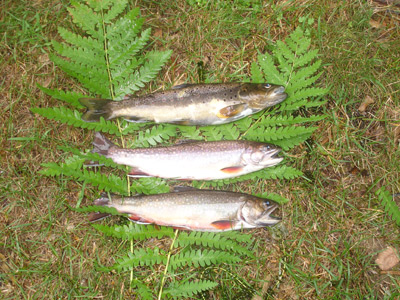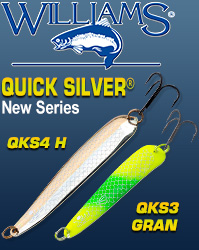FENCEROWS...“To Kill a Trout”
By John Luthens
It is the tail end of the August dog days. The pines sag over the drive and spider webs glisten with morning dew in the tall grass. There will be frost in the same grass soon enough. It is time.
The waters I am walking into will put on a show. I know the dark and curling runs where the trout rest. I know them by heart, even though I haven’t fished the tangled stream in over a year. In fact, I’ve seldom fished it more than once a year. Still, I’ve gone there religiously since I was 10 years old.
I’m 43 now; not exactly ancient, but still a far cry from the young boy my grandfather first dropped off at this very spot 33 years ago. But I still go to these old waters with the same spring in my step that I had as a boy.
Back then, I fought down the banks with my dime-store rod and tackle, dressed for battle in blue jeans and a hooded sweatshirt to ward off mosquitoes. I went with the solemn and sole purpose of killing a trout.
I have neoprene waders and endless pocket fishing vests now, and ultra-weighted graphite rods that I wistfully part through the densest alder thickets with the ease of a magic wand. I used to get tangled up all the time with my low-grade gear. Now I’m simply tangled with more expensive stuff.
One thing remains constant. Thirty-three years later, I’m going into the overhanging grass and brush choked banks of an ancient trout stream to do it again. I’m going to kill a trout.
Catch and release philosophy has finally crept into my value system. It’s probably for the better. Sporting groups, fisheries biologists and DNR improvement programs have tried to ensure that Wisconsin remains a must-see in the livewells of sport fishing destinations.
Invariably, there is also pressure for the catch and release mentality from many of the same groups that have helped nurture the renowned fishing experienced in our state. I see the yellow and black signs posted on fishing access points all the time-“Consider the catch and release.”
There are no signs in this cut valley-no worn fishermen’s paths either. But still the ethics remain, as I slide down the hill and navigate the pine deadfalls that have leaned and fallen over this small stream valley for generations.
Like the leaning pines, I have swayed my principles towards the pinnacle of trout fishing: Fishing for the thrill of the sport, releasing what I catch, and whistling a happy tune on my way home with an empty creel beating time against my waders.
It takes a while to walk back in here. I walk atop a ridge overshadowing the stream, with narrow pine gullies that cut steeply down to the water. I can slide through the brush down any one of them to hit the water. It all depends on how far back into the wilderness I want to go.
I finally take the plunge, boots down and rod tip up, and I smell the bog growth and the cold stream before I see it. A fallen spruce lies across the stream. The water is cut deep beneath its tangled branches. I don’t remember it. It must have fallen since the last time I crawled into this jungle.
There is only going to be one shot at this. I crawl over spruce roots, where earth is tossed in rich, black clumps. This old giant must have made quite a roar going down-maybe a wind storm or a lightning strike, it’s hard to tell because most of the tree lies buried in the water now. I inch my way above the bank. I flip my night crawler into the rushing current and it drags into the dark, tangled branches.
My line tugs hard three times and then takes off hard under the fallen log. There is no time to play this fish. I yank back, and the cold weight of a fighting trout catches for a moment in the sunken mess before plummeting upwards and onto the sloping bank behind me.
It’s a good fish, a brown trout of 12 inches, maybe 13. I don’t have a measuring tape, so I’ll claim 13 to anyone who’ll sit still long enough for me to brag. I pull watercress and ferns from the bank and wrap the brown to keep it fresh; then I pocket the trout in my creel.

Three trout for breakfast, taken from a northwestern Wisconsin brush stream.
There can be more than one fish in a hole like this, but I don’t want to press my luck. When I go to kill a trout, I don’t like to play out one spot. I know another nice fish will move into the spruce tangles to boss the hole soon enough. I’m going to slip into the water and move downstream. The trout is still flopping alive and hard in my creel. It’s a good feeling.
The easiest way to fish a small, over-hung creek like this is to get right down into the water and move slow. I know trout face up current in their feeding lies, but fishing upstream makes too much noise against the current for my liking. It’s hard enough ducking under all the brush without making a ruckus.
Fly fishing trout experts will say different, but I’ve never considered myself an expert, so I’m wading downstream. You have to stay low, almost crouching, and you need to go slow. It might take me an hour to move 50 yards. It’s surprising how close you can get without sending the trout flying.
I have run on the fringes of some of these trout experts that won’t deem you worthy of their inner circle unless you, without exception, throw back what you catch. They have specific ideas about the circle of life. I try to stay back, so I don’t implode their idealistic views.
If that sounds a little bitter and harsh, it’s only because these idealists catch way more fish than I do. Truth be told, I’m a little jealous. I’ve come to my own realizations on catch and release over the years. My ideas have come slowly; taking shape like my careful wading of the runs on this little creek.
If I catch a musky, I wouldn’t consider keeping it, even if it was a trophy fish. The sporting industry and the good name of Wisconsin fishing relies heavily on the fact that there is big fish potential in our waters-even if it takes 1000 casts to hook into one.
I do the same thing on walleye lakes that have been nurtured by lake associations or by sporting groups such as Walleyes For Tomorrow. I play by their home rules regarding bag and slot limits. They have put a lot of money and effort into nurturing and sustaining their fisheries.
Trout Unlimited stream improvements- it’s the same deal-I’ll catch and release trout all day on those rivers so others can enjoy the benefits of the cause. On the other side of the coin, if the same organizations want bass, pike, or pan fish thinned out on any given water, I’m happy to oblige. I love a good fish fry.
It boils down to what you know and understand about the biology of your home waters, and this small brush stream is what I know best. I said I only fish it once a year or so, and that was true as far as actual fishing goes. But I am down on this stream a lot more than that. I walk it in the fall, and I walk it in the winter. I see habitat changes, like the fallen spruce tangled in the dark water. While I am no fish biologist, I have come to have a decent understanding of the health of this small stream.
Trout streams can be fished out. That is a fact. But this one is very hard to access and extremely difficult to fish if you don’t spend a lot of time getting to know it. The fishing pressure is virtually non-existent. And at the tail end of summer, the bank weeds and brush are so overgrown that a machete would get a heavy work-out.
It’s my kind of place, and though I have to earn it, I fall hard from the catch and release pinnacles once a year here. I would sooner eat a trout fried up with bacon than any of the finest seafood served on a silver platter in a five-star restaurant.
There’s a deep bend in the stream up ahead. It’s taken a while to get here, and I’ll need to poke my rod though a network of alders to give myself a chance. I know there’s some big brook trout hanging on the edges of the run. I’ve watched them in the winter while lying on my belly in the snow.
I’m going to try and get one. If you’ve never had trout and bacon for breakfast, you’re missing out on an ultimate link in the circle of life. I’m all for catch and release, but 33 years of fishing this stream is a hard habit to break. Now that I’ve crawled my way in here, I might as well get one or two more for the pan.









